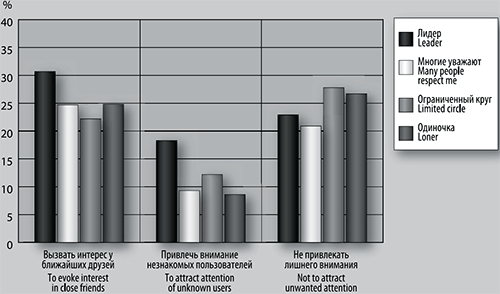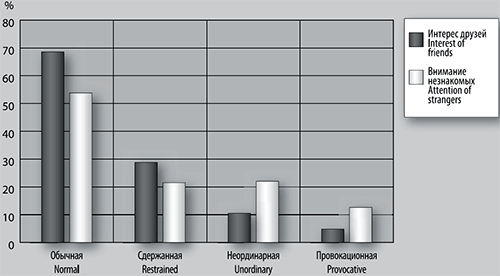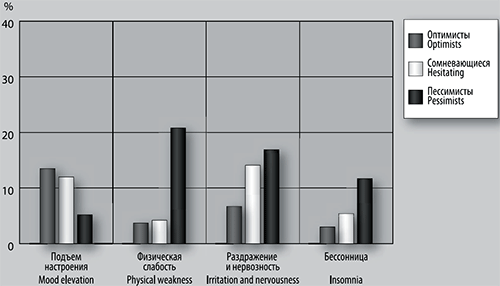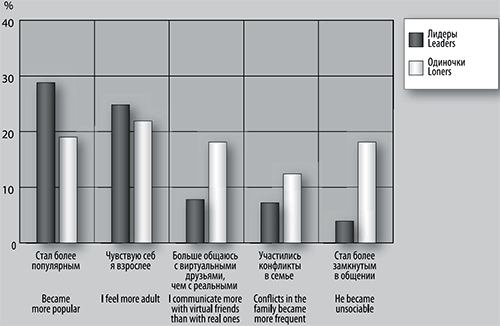Article
Sobkin V.S., Fedotova A.V. (2018) Adolescent in social networks: on the issue of social psychological well-being. National Psychological Journal. 3, 23-36.
Abstract
Background. Digital technologies have long become an integral part of everyday life. Internet and Social Networking Sites (SNS) are considered to be one of the socialization institutions along with traditional school and family.
Objective. The research is concerned with studying the peculiarities of teenagers’ social psychological well-being when using SNS. The analysis aims at revealing the impact of demographic, social stratifying and social psychological factors on the type of adolescent self-performance at SNS, their attitude towards regulations of interaction at SNS, their concern about potential risks and also opinions about the effects of SNS socialization on their personality.
Design. The paper is based on the results of 2074 school-aged adolescent survey conducted in 2016 in Moscow region, Russia.
Results. According to the survey, the adolescent well-being when using SNS depends on the type of their self-presentation. The data showed that affective significance of social networking for adolescents who seek the attention of the strangers produces a negative impact on their emotional well-being: those who refer to their SNS profile as “provocative” are more likely to feel the “addiction to virtual interaction and other’s opinions” – 17.4% (mean 7.1%; p≤ .0004), being disturbed by “more popular profiles” – 21,7% (mean 4.2%; p≤ .00001).
Conclusion. The survey showed that nowadays adolescents deem the SNS as the most important communicative field where the fundamental age-related changes take plaare foundce. The tendency to expand social contacts by means of virtual communication was found to produce negative impact on adolescent personal development and social interaction in real life.
Accepted: 05/07/2018
Pages: 23-36
DOI: 10.11621/npj.2018.0303
PDF: Download
Keywords: social networks; SNS performance; adolescence; self-presentation; regulations; Internet addiction; social status; social psychological well-being;
Available Online 30.09.2018

Fig. 1. Different target settings in adolescents when creating a profile in a social network with different status in the class (%)

Fig. 2. Differences in the evaluation of one’s web page in a social network depending on the communicative goal (%)

Fig. 3. Age dynamics of network communication risks (%)

Fig. 4. Evaluation of one’s own emotional state by adolescents with long-term inability to use the social network depending on frequency of using social network (%)

Fig. 5. Experiences of adolescents with long-term inability to use the social network depending on the assessment of their life prospects

Fig. 6. Attitude of adolescents with different self-assessment values of their status in the class to the consequences of using social networks (%)
Table. 1. General distribution and age-related dynamics of student responses to the question of the importance of restrictive regulations of communication in the network (%)
|
|
mean |
5th form |
7th form |
9th form |
11th form |
|
Information showing disrespect and disregard for other users and their interests, or |
36.1 |
35.2 |
37.2 |
34.7 |
38.0 |
|
personal insults to other users |
49.5 |
53.1 |
50.6 |
49.7 |
40.0 |
|
Erotic information from the user's personal life |
41.3 |
37.5 |
43.1 |
42.5 |
42.3 |
|
Content of aggressive nature. including unprintable speech and bullying other network users |
33.2 |
32.0 |
33.4 |
32.7 |
36.0 |
|
Showing disrespect to religious issues |
25.5 |
23.6 |
23.7 |
28.1 |
27.3 |
|
Showing disrespect to national issues |
25.6 |
21.2 |
24.6 |
27.5 |
32.3 |
|
Showing disrespect to the state |
25.3 |
26.4 |
25.6 |
24.6 |
23.7 |
|
Only the content that contradicts the rules of social network administration |
13.2 |
10.5 |
11.3 |
15.6 |
17.3 |
|
only the content that entails legal liability |
15.8 |
10.7 |
12.9 |
19.8 |
23.3 |
|
N |
2074 |
571 |
613 |
590 |
300 |
Table 2. Attitude of adolescents to personal changes that occurred under the influence of the network depending on frequency of using social network (%)
|
|
mean |
Less than 1 hr |
More than 5 hrs |
p≤ |
|
I became more confident in real communication with my peers |
36.0 |
33.5 |
46.7 |
.0002 |
|
I became more popular among my peers |
17.6 |
12.7 |
25.9 |
.00001 |
|
My circle of communication expanded significantly |
37.9 |
31.5 |
49.6 |
.00001 |
|
I learned more about majors I take interest in |
30.0 |
30.9 |
28.5 |
– |
|
I improved my academic performance |
10.0 |
11.0 |
11.5 |
– |
|
I began to feel more mature |
18.2 |
16.4 |
30.4 |
.00001 |
|
I have acquired new interests |
41.7 |
38.0 |
47.8 |
.005 |
|
I began to communicate with "virtual" friends than with real ones more often |
7.7 |
4.7 |
19.6 |
.00001 |
|
Conflicts in my family increased |
5.4 |
4.2 |
8.5 |
.003 |
|
My academic performance decreased |
6.2 |
6.2 |
11.5 |
.002 |
|
My interest in current hobbies decreased |
4.0 |
2.6 |
7.4 |
– |
|
I became more closed in communicating with classmates and acquaintances |
3.7 |
3.6 |
7.0 |
.05 |
|
N |
2074 |
645 |
270 |
|
Table 3. Fixing adolescent consequences of network communication depending on attitude to their webpage (%).
|
|
average |
reserved |
explicit |
provocative |
|
I became more popular among my peers |
17.2 |
21.4 |
38.8 |
29.3 |
|
I began to feel more mature |
17.9 |
22.8 |
43.7 |
41.3 |
|
I began to communicate with "virtual" friends than with real ones more often |
7.1 |
7.9 |
25.2 |
23.9 |
|
Conflicts in my family increased |
5.2 |
7.3 |
18.4 |
21.7 |
|
My academic performance decreased |
6.4 |
7.5 |
15.5 |
18.5 |
|
I became more closed in communicating with classmates and acquaintances |
3.5 |
5.3 |
13.6 |
13.0 |
|
N |
1416 |
509 |
103 |
92 |
References:
Belinskaya, E.P. (2013) Information socialization of adolescents: the experience of using social networks and psychological well-being. [Psikhologicheskie issledovaniya], 6(3), 5.
Bogacheva, N.V. (2014) Computer games and psychological specifics of the cognitive sphere of gamers. [Vestnik Moskovskogo Universiteta]. Series 14. Psychology, 4, 120–130.
Bogacheva, N.V. (2015) Computer games and the psychological specifics of the gamer cognitive sphere (ending). [Vestnik Moskovskogo Universiteta]. Series 14. Psychology, 1, 94–103.
Brenner, V. (1997) Parameters of Internet Use, abuse, and addiction: The first 90 days of the Internet Usage Survey. Psychological Reports, 80 (3 Pt1), 879–882. doi: 10.2466/pr0.1997.80.3.879
El'konin, D.B. (1989) Selected psychological works. Moscow, Pedagogika.
Erickson, E. (1996) Identity: youth and crisis: Trans. from the English; Society. Moscow, Izdatel’stvo gruppa "Progress".
Görzig, A. (2011) Who bullies and who is bullied online? A study of 9-16 year old internet users in 25 European countries. Retrieved from http://eprints.lse.ac.uk/39601/
Gross, E.F. (2004) Adolescent Internet use: What we expect, what teens report. Applied Developmental Psychology, 25, 633–649. doi: 10.1016/j.appdev.2004.09.005
Kennedy-Souza, B. L. (1998). Internet Addiction Disorder. Interpersonal Computing and Technology: An Electronic Journal for the 21st Century, 6, 1–8.
Koroleva, D.O. (2015) Using social networks in the education and socialization of adolescents: an analytical review of empirical research (international experience). [Psihologicheskaya nauka i obrazovanie], 20(1), 28–37.
Kulikova, T.I., & Maliy, D.V. (2015) The correlation between a passion for computer games and the school performance of younger schoolchildren. Psychology in Russia: State of the Art, 8(3), 124–136.
Laghi, F., Schneider, B.H., Vitoroulis, I. at al. (2013) Knowing when not to use the Internet: Shyness and adolescents’ on-line and off-line interactions with friends. Computers in Human Behavior, 29, 51–57. doi: 10.1016/j.chb.2012.07.015
Livingstone, S., Haddon, L., Görzig, A. & Ólafsson, K. (2011) Risks and safety on the internet: The perspective of European children: Full findings. Retrieved from http://eprints.lse.ac.uk/33731/.
Livingstone, S., Kirwil, L., Ponte, C., & Staksrud, E. (2013) In their own words: what bothers children online? with the EU Kids Online Network. EU Kids Online, London School of Economics & Political Science, London, UK. Retrieved from http://eprints.lse.ac.uk/48357/.
Manago, A.M., Graham, M.B., Greenfield, P.M., & Salimkhan, G. (2008) Self-presentation and gender on MySpace. Journal of Applied Developmental Psychology, 29, 446–458. doi: 10.1016/j.appdev.2008.07.001
Manzi, C., Coen, S., Regalia, C., Yévenes, A.M., & Vignoles, V.L. (2018) Being in the Social: A cross-cultural and cross-generational study on identity processes related to Facebook use. Computers in Human Behavior, 80, 81–87. Retrieved from https://doi.org/10.1016/j.chb.2017.10.046. doi: 10.1016/j.chb.2017.10.046
Marcinkovskaya, T.D. (2010) Information space as a factor of socialization of modern adolescents. [Mir pikchologii], 3, 90–102.
Marino, C., Gini, G., Vieno, A., & Spada, M.M. (2018) The associations between problematic Facebook use, psychological distress and well-being among adolescents and young adults: A systematic review and meta-analysis. Journal of Affective Disorders, 226, 274–281. doi: 10.1016/j.jad.2017.10.007
Oprea, C., Stan, A. (2012). Adolescents perceptions of online communication. Procedia – Social and Behavioral Sciences, 46, 4089–4091. doi: 10.1016/j.sbspro.2012.06.204
Polivanova, K.N., & Smirnov, I.B. What's in my profile to you: data "VKontakte" as a tool for studying modern interests of adolescents. [Voprosy obrazovaniya], 2. 134–152.
Puchkova, E.B., Sukhovershina Yu.V., & Temnova L.V. (2017) A study of Generation Z’s involvement in virtual reality. Psychology in Russia: State of the Art, 10(4), 134–143.
Sipal, R.F., Karakaya, Y., & Hergul, N. (2011) I am online: What adolescents think about internet and internet use. Procedia – Social and Behavioral Sciences, 30, 2420–2426. doi: 10.1016/j.sbspro.2011.10.473
Sobkin, V.S., & Evstigneeva, Iu.M. (2004) The Adolescent: Virtual and Social Reality. Russian Education and Society, 46(6), 6–100. doi: 10.1080/10609393.2004.11056893
Sobkin, V.S., & Evstigneeva, Iu.M. (2004) The Adolescent: Virtual and Social Reality. Russian Education and Society, 46(7), 3–92. doi: 10.1080/10609393.2004.11056901
Sobkin, V.S. (2017) Adolescent: Inclusion into the Network Interaction and Attitude to Education, in: Communications. Media. Design, 2(2), 99–113.
Sobkin, V.S. (2016) The modern teenager in social networks. [Pedagogika], 8, 61–72.
Sobkin, V.S., & Adamchuk, D.V. (2006) Attitude of the participants in the educational process to information and communication technologies (based on the sociological survey of school administrators, teachers and students in the pilot regions of the ISO project). Moscow, Tsentr sotsiologii obrazovaniya RAO.
Sobkin, V.S., & Evstigneeva, Yu. M. (2001) Adolescent: Virtuality and Social Reality. On the basis of sociological research. Works on the Sociology of Education. Volume VI. Issue X. Moscow, Tsentr sotsiologii obrazovaniya RAO.
Sobkin, V.S., & Adamchuk, D.V. (2008) Monitoring social consequences of informatization: what has changed in school in the course of three years? Tsentr sotsiologii obrazovaniya RAO.
Sobkin, V.S., & Fedotova, A.V. (2018) Adolescent in social networks: risks and reactions. [Voprosy psikhicheskogo zdorov'ya detey i podrostkov], 1, 47–56.
Soldatova, G.V., Zotova, E.Yu., Chekalina, A.I., & Gostimskaya O.S. (2011) Caught by one network: a socio-psychological study of the views of children and adults about the Internet. Internet Development Fund. Moscow.
Trekels, J., Ward, L.M., & Eggermont, S. (2018) I “like” the way you look: How appearance-focused and overall Facebook use contribute to adolescents' self-sexualization. Computers in Human Behavior, 81, 198–208. doi: 10.1016/j.chb.2017.12.020
Turkle, Sh. (1996) Parallel lives: Working on identity in virtual space. Constructing the self in a mediated world. Inquiries in social construction. Grodin D., Lindlof T.R. (Eds.). Sage Publications, Inc, Thousand Oaks, CA, US, 156–175.
Voiskounsky, A.E. (2010) Internet Addiction in the Context of Positive Psychology. Psychology in Russia: State of the Art, 3, 541–549.
Voiskunsky, A.E. (2004) Actual problems of the psychology of dependence on the Internet. [Psikhologicheskiy zhurnal], 25(1), 90–100.
Vygotsky, L.S. (1984) Pedology of an adolescent. Vol. 4. [Sobranie sochineniy]. Moscow, In 6 Vols.
Young, K. S. (1998). Internet addiction: The emergence of a new clinical disorder. CyberPsychology and Behavior, 3(1), 237–244. doi: 10.1089/cpb.1998.1.237
Zichkina, A.Y. & Belinskaya, E.P. (2000) Self-presentation in virtual communication and identity features of adolescent Internet users. [Obrazovanie i informatsionnaya kul'tura. Sotsiologicheskie aspekty. Trudy po sotsiologii obrazovaniya], V(VII). Moscow, Tsentr sotsiologii obrazovaniya RAO, 431–460.For citing this article:
Sobkin V.S., Fedotova A.V. (2018) Adolescent in social networks: on the issue of social psychological well-being. National Psychological Journal. 3, 23-36.


